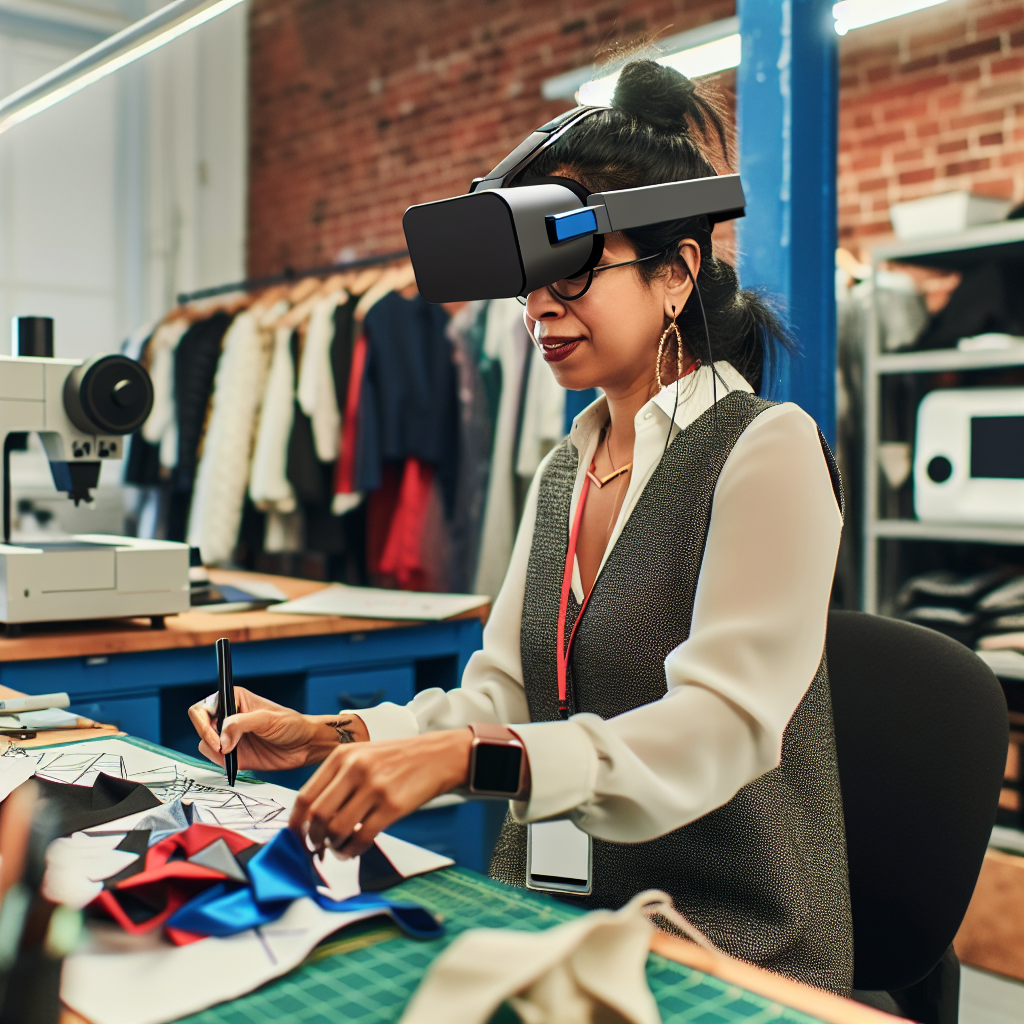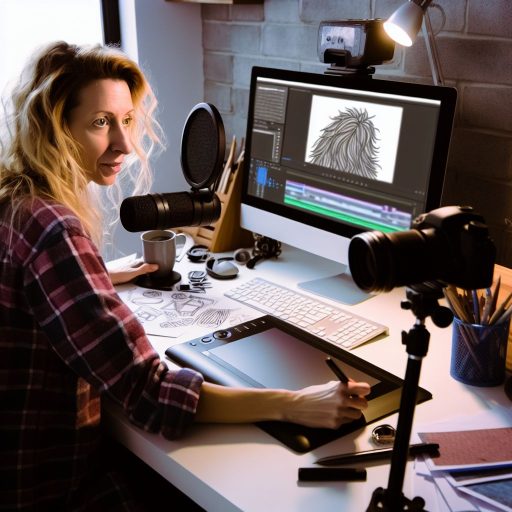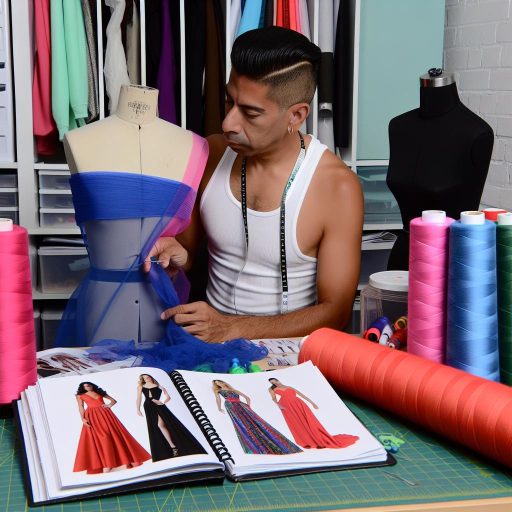Introduction to Technology in Fashion Design
Technology significantly impacts modern fashion design.
Designers now leverage various digital tools and software in their creative process.
This integration enhances creativity and efficiency in garment creation.
For instance, 3D modeling allows designers to visualize patterns and structures.
Moreover, computer-aided design (CAD) software streamlines the design process.
Such innovations reduce time spent on manual sketches and revisions.
Emergence of Fashion Tech
The rise of fashion technology has transformed how designers operate.
Wearable technology introduces new materials and functionalities.
These advancements include smart fabrics that monitor health metrics.
Additionally, augmented reality (AR) offers immersive shopping experiences.
This technology aligns products with consumer preferences in real time.
Sustainable Practices through Technology
Technology also drives sustainability in fashion design.
Innovative tools help reduce waste and energy consumption.
For example, virtual sampling eliminates the need for physical prototypes.
Thus, it minimizes fabric waste significantly during the production process.
Furthermore, digital platforms facilitate recycling and upcycling initiatives.
Collaboration and Global Reach
Technology fosters collaboration among designers globally.
Online platforms allow for idea and resource sharing across borders.
Consequently, fashion houses can easily access talented individuals worldwide.
This interconnectedness inspires fresh designs and diverse influences.
As a result, the fashion industry becomes more innovative and adaptive.
The Impact of Computer-Aided Design (CAD) Software
Overview of CAD in Fashion Design
Computer-Aided Design software revolutionizes the fashion design industry.
Designers use CAD to create intricate patterns and styles efficiently.
Additionally, CAD enhances accuracy in garment specifications.
This software simplifies the process of visualizing concepts before production.
Unlock Your Career Potential
Visualize a clear path to success with our tailored Career Consulting service. Personalized insights in just 1-3 days.
Get StartedStreamlining the Design Process
CAD significantly reduces the time needed for design iterations.
Designers can experiment with colors and textures virtually.
This technique promotes faster decision-making on design elements.
As a result, brands can better meet consumer trends and demands.
Collaboration and Communication
CAD tools foster collaboration among design teams globally.
Digital files can be easily shared across various stakeholders.
This sharing enables real-time feedback and adjustments to designs.
Moreover, clear communication helps in aligning vision across teams.
Cost-Effectiveness and Sustainability
Using CAD software lowers production costs in the fashion industry.
It reduces material waste by allowing precise pattern making.
Additionally, it supports sustainable practices in design.
Designers can simulate various materials without physical samples.
Innovations in Design Aesthetics
CAD opens new avenues for creativity in fashion design.
Designers can easily integrate 3D modeling into their work.
This advancement promotes the development of unique and complex designs.
As a result, brands can differentiate themselves in a competitive market.
3D Printing and Its Influence on Fashion Production
Transforming Design Processes
3D printing revolutionizes the fashion design landscape.
It allows designers to create intricate patterns and structures.
Moreover, this technology minimizes the time from concept to final product.
Many designers now embrace rapid prototyping for their collections.
Enhancing Customization
The capability for customization has significantly increased with 3D printing.
Consumers can now tailor designs to their specific preferences.
This personalization enhances customer engagement and loyalty.
As a result, brands like Nike and Adidas have adopted custom 3D printed elements.
Reducing Waste
One of the critical benefits of 3D printing in fashion is waste reduction.
This technology uses only the necessary materials for each piece.
Consequently, it minimizes excess fabric and production waste.
Many fashion brands are now focusing on sustainable practices.
Case Studies
Several companies have successfully integrated 3D printing into their operations.
For instance, Iris van Herpen showcases stunning designs through this technology.
Similarly, New York-based brand Krush offers unique, 3D-printed accessories.
Both brands exemplify the fusion of art and technology in fashion.
You Might Also Like: Exploring Lucrative Niches in the Photography Industry
Virtual Reality and Augmented Reality in Fashion Showcases
The Emergence of VR and AR Technologies
Virtual Reality and Augmented Reality are changing fashion showcases dramatically.
Designers embrace these technologies to enhance audience engagement.
They provide immersive experiences that captivate viewers.
Consequently, brands create unique virtual fashion shows.
Enhancing the Fashion Experience
VR technology allows users to experience runway shows remotely.
Viewers feel as if they are physically present at the event.
This experience broadens the audience reach significantly.
Moreover, AR applications enable customers to virtually try on clothes.
Shoppers can see how garments fit without leaving their homes.
Impact on Fashion Marketing
Fashion labels effectively market their collections through VR and AR.
They generate excitement and anticipation before product launches.
This innovative approach also creates shareable content on social media.
As a result, consumers stay engaged with brands longer.
Case Studies of Implementation
Numerous brands have successfully adopted VR and AR in their showcases.
Balenciaga hosted an immersive VR experience for its latest collection.
Customers could explore a virtual showroom filled with digital garments.
Similarly, Gucci used AR for its mobile app, allowing virtual try-ons.
These initiatives demonstrate technology’s potential in modern fashion.
Challenges and Considerations
Despite the advantages, challenges remain in adopting these technologies.
High costs can deter smaller brands from utilizing VR and AR.
Additionally, technical glitches can hinder user experience.
Brands must invest in quality technology to avoid these issues.
Furthermore, they need to ensure accessibility for all users.
See Related Content: Building a Personal Brand as a Canadian Fashion Designer
Sustainable Fashion Through Technological Innovations
Introduction to Sustainable Fashion
Sustainable fashion focuses on minimizing environmental impact.
It aims to create clothing using eco-friendly practices.
Moreover, it considers ethical labor practices during production.
The Impact of Technology on Sustainability
Technology revolutionizes the fashion industry in various ways.
Advanced materials boost sustainability while reducing waste.
For instance, biodegradable fabrics break down naturally.
Additionally, 3D printing reduces material waste during production.
Innovative Fabric Technologies
New technologies develop innovative fabrics with sustainable properties.
For example, recycled polyester reuses plastic bottles.
Similarly, organic cotton reduces pesticide usage during cultivation.
Such fabrics create a lower carbon footprint compared to conventional options.
Digital Tools for Sustainable Design
Digital design tools simplify the sustainable fashion process.
Computer-aided design (CAD) enables efficient pattern creation.
This method minimizes fabric waste before production begins.
Furthermore, virtual fitting rooms allow for better size accuracy.
Supply Chain Innovations
Supply chain technology enhances transparency and traceability.
Blockchain technology records every step in production.
This feature ensures ethical sourcing and fair labor practices.
The Role of AI and Big Data
Artificial intelligence predicts fashion trends accurately.
Big data aids brands in understanding consumer behavior.
Consequently, brands produce only what is necessary, reducing overproduction.
Consumer Awareness Through Technology
Technology educates consumers about sustainable fashion choices.
Apps provide information on the sustainability of brands.
This transparency empowers consumers to make informed decisions.
Collaboration Between Designers and Tech Companies
Partnerships between fashion designers and tech companies thrive.
These collaborations foster creative solutions for sustainable practices.
For example, the collaboration between Stella McCartney and Adobe enhanced sustainable design methods.
Future Trends in Sustainable Fashion Technology
The future holds promising developments in sustainable fashion technology.
Innovations like nanotechnology may create smarter materials.
Predictive analytics will further refine production processes.
Ultimately, these advancements will shape a more sustainable industry.
You Might Also Like: Essential Gear for Beginner Photographers in Canada

E-commerce and Online Retail Advancements in Fashion
The Rise of Online Shopping
Online shopping has transformed the fashion industry.
Customers can now browse luxury brands from their homes.
This convenience drives consumers to prefer online transactions.
Moreover, delivery services have improved significantly.
Fast shipping enhances customer satisfaction and loyalty.
Personalization Through Technology
Technology enables brands to offer personalized shopping experiences.
Data analytics allows companies to understand consumer preferences.
Consequently, tailored recommendations enhance sales potential.
Brands now use AI chatbots for customer support and guidance.
These advancements lead to improved customer interactions.
The Impact of Social Media
Social media plays a vital role in fashion marketing today.
Platforms like Instagram and TikTok influence consumer choices greatly.
Fashion brands showcase their collections through engaging content.
User-generated content creates authenticity and trust.
Consequently, social media marketing drives online sales exponentially.
The Emergence of Mobile Shopping
Mobile commerce is a growing trend in the fashion industry.
Customers prefer shopping from their smartphones and tablets.
This shift requires brands to optimize their mobile applications.
Easy navigation and secure payment options enhance user experience.
As a result, mobile shopping continues to gain traction.
The Role of Augmented Reality
Augmented reality (AR) offers innovative ways to shop online.
Customers can visualize clothing items before purchase.
This technology reduces return rates significantly.
Brands utilize virtual fitting rooms to enhance consumer confidence.
AR transforms the online shopping experience, making it dynamic.
Explore Further: How to Set Competitive Pricing as a Canadian Photographer
Social Media’s Role in Fashion Marketing and Customer Engagement
The Rise of Social Media Platforms
Social media has transformed fashion marketing strategies.
Platforms like Instagram and TikTok lead the way.
These networks allow brands to showcase their latest collections instantly.
Moreover, they provide a space for direct customer interaction.
Influencer Collaborations
Fashion brands now collaborate with social media influencers.
Influencers have become key partners for marketing campaigns.
They reach targeted audiences effectively and authentically.
This strategy enhances brand visibility and appeal.
User-Generated Content
User-generated content plays a vital role in engagement.
Brands encourage customers to share their own photos.
This creates a sense of community around the brand.
Additionally, it provides real-life testimonials and reviews.
Real-Time Feedback and Insights
Social media enables brands to gather feedback instantly.
Companies can gauge customer reactions to new designs.
This real-time data is crucial for adapting strategies.
Furthermore, it enhances customer satisfaction and loyalty.
Creating a Brand Narrative
Brands use storytelling on social media to connect with audiences.
Narratives develop emotional connections with customers.
A compelling story can enhance brand identity significantly.
Effective storytelling generates buzz and engagement.
Utilizing Analytics and Insights
Social media platforms offer valuable analytics tools.
Brands analyze metrics to refine their marketing strategies.
Data-driven decisions improve campaign effectiveness.
This focuses efforts on what resonates most with consumers.
Wearable Technology: Merging Fashion with Functionality
Introduction to Wearable Technology
Wearable technology reshapes how we view fashion today.
This innovation combines style with practical features.
Designers create pieces that serve multiple functions.
Wearables enhance everyday life through technology.
Key Innovations in Wearable Technology
Smartwatches lead the charge in wearable tech.
These devices track health and fitness metrics effortlessly.
Smart clothing is another emerging trend.
For example, clothing embedded with sensors monitors vital signs.
Wearable devices now integrate seamlessly into everyday attire.
Impact on Fashion Industry
Technology influences designers like never before.
Fashion shows now feature tech-savvy outfits.
Designers experiment with fabrics that react to environments.
Moreover, brands collaborate with tech companies for new designs.
Such partnerships expand the creative horizons vastly.
Consumer Engagement Through Customization
Wearables allow personalization in fashion choices.
Consumers can tailor devices to reflect their style.
This customization extends to color, design, and functionality.
Technology encourages unique expressions for each individual.
Challenges Facing Integration
Despite the benefits, challenges remain for wearable tech.
Fashion and tech must harmonize without sacrificing style.
Additionally, durability is a key concern for designers.
Wearable devices must withstand everyday wear and tear.
Privacy issues also arise with the data collected by devices.
Future Trends in Wearable Fashion
The future holds even more innovative possibilities.
Augmented reality will soon influence wearable design.
Wearables will incorporate AI for more personalized experiences.
Furthermore, sustainability will become a focus for designers.
The combination of fashion and sustainability is key moving forward.
Additional Resources
How Iris van Herpen Transformed Fashion — Google Arts & Culture




